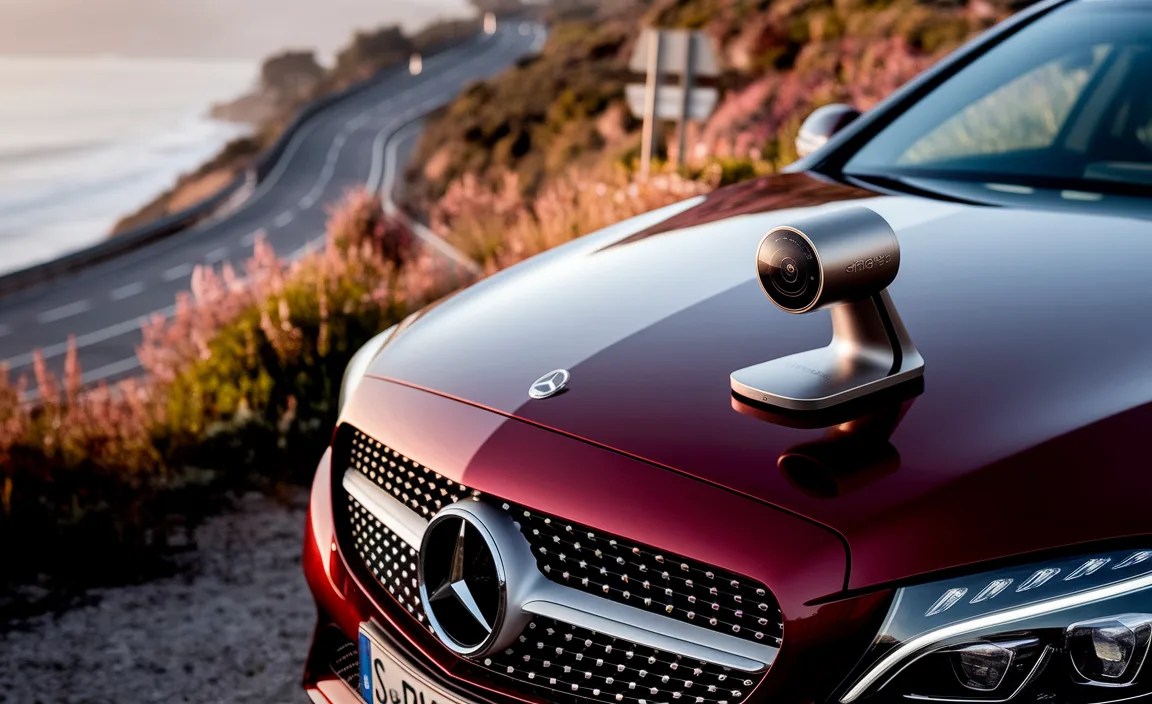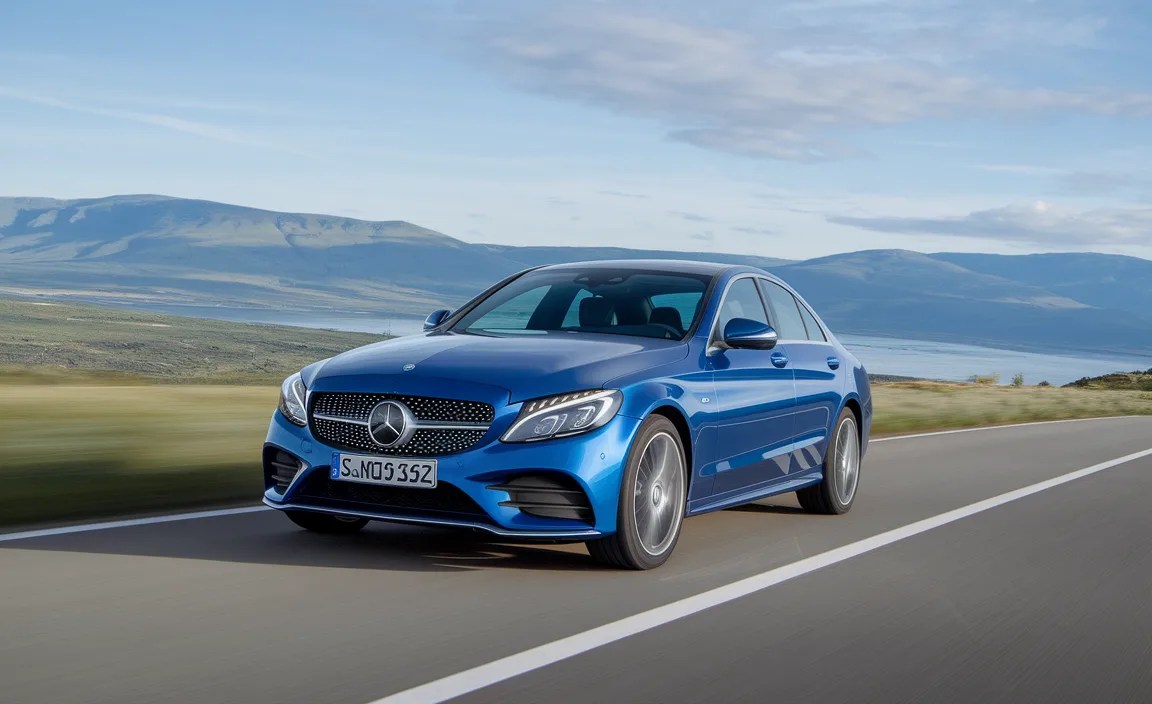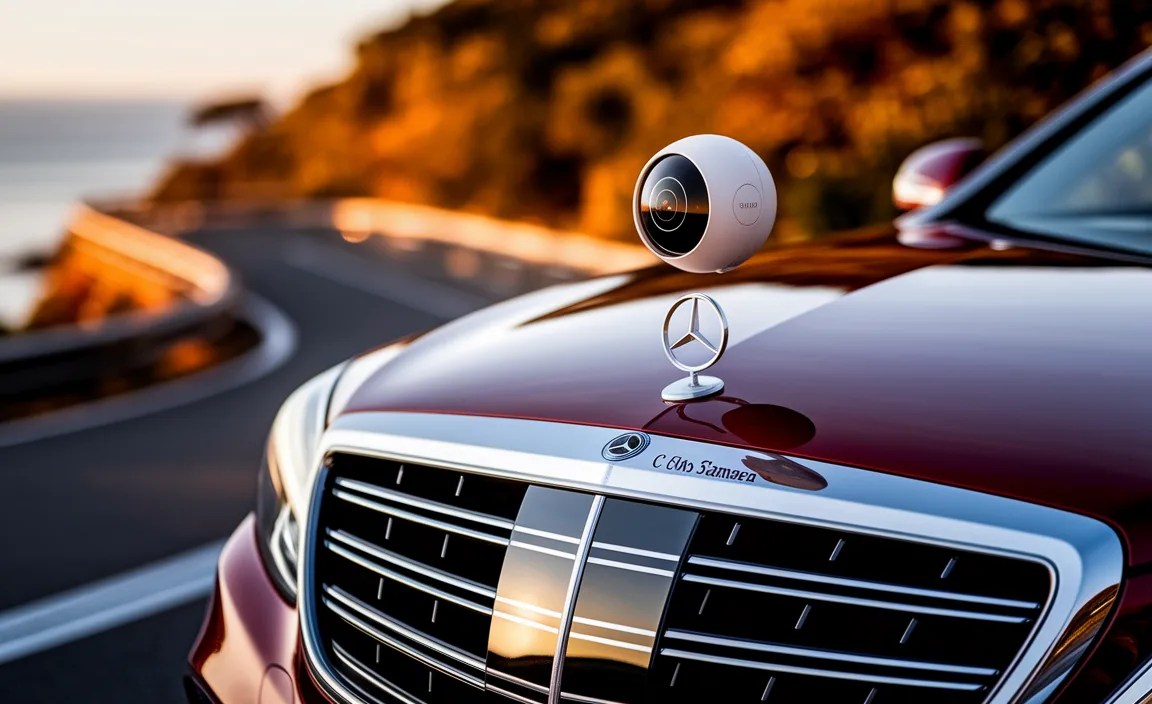C Class 360 Camera: Ultimate Parking Perfection
Parking can sometimes feel like navigating a maze, especially in tight city spots or busy lots. But what if your Mercedes-Benz C Class could give you eyes all around? That’s precisely what the C Class 360 Camera system offers – a bird’s-eye view of your surroundings, making parking maneuvers effortless and stress-free. This advanced technology transforms a common driving challenge into a simple, confident task. Let’s dive into how this incredible feature works and how you can use it to achieve parking perfection every time.

Unlocking Parking Confidence: How the C Class 360 Camera Works
The Mercedes-Benz C Class 360 Camera system, often referred to as the Surround View System, revolutionizes how you perceive your vehicle’s environment. It’s not just a rearview Camera; it’s a network of strategically placed cameras that work in harmony to create a composite, top-down view of your C Class and its immediate surroundings. This comprehensive perspective is displayed on your vehicle’s central infotainment screen, giving you an unparalleled understanding of clearances and obstacles.
The Technology Behind the Bird’s-Eye View
At its core, the 360 Camera system is an intelligent integration of multiple camera modules. Typically, you’ll find:

Front Camera: Located in the grille, it captures what’s directly in front of your C Class, crucial for navigating out of parking spaces or approaching curbs.
Rearview Camera: Situated above the license plate, this is your traditional backup camera, offering a clear view of what’s behind you.
Side Mirror Cameras: One camera is integrated into the underside of each side mirror. These are vital for seeing the sides of your vehicle, identifying low-lying obstacles, or aligning yourself with parking lines.
These individual camera feeds are not just displayed separately. Advanced software stitches them together in real-time to generate a cohesive, 360-degree perspective. This “virtual top-down” or “bird’s-eye” view is the magic that simplifies parking. You can also often switch to individual camera views – front, rear, or side – depending on your specific needs during a maneuver.
Why a 360 Camera is a Game-Changer for Your C Class
Parking can be a source of anxiety for many drivers. Tight spaces, blind spots, and the fear of scuffing wheels or bumping into objects can make even a simple parking job feel daunting. The 360 Camera system directly addresses these concerns by:
Eliminating Blind Spots: Those areas around your car that you just can’t see with mirrors alone are brought into full view.
Providing Precise Distance Guidance: The system often superimposes dynamic guidelines that indicate your projected path, helping you maneuver with incredible accuracy.
Enhancing Safety: By giving you a clear view of pedestrians, cyclists, and other vehicles, it significantly reduces the risk of low-speed collisions.
Boosting Confidence: Knowing you have this incredibly helpful technology at your disposal naturally makes you feel more confident and less stressed when parking.
Getting Started: Activating and Using Your C Class 360 Camera
The beauty of the C Class 360 Camera system is its intuitive integration into your driving experience. It’s designed to be ready when you are, making it incredibly easy for beginners to leverage its full potential.

Automatic Activation and Access
Most Mercedes-Benz C Class models equipped with the 360 Camera system will automatically activate certain camera views when you engage reverse gear. You’ll immediately see the rearview camera on your COMAND or MBUX infotainment display. However, to access the full 360-degree birds-eye view and other camera perspectives, you’ll typically need to:
1. Engage Reverse Gear (R): This is the primary trigger for the system to display parking views.
2. Select the Camera Button: On the central console or steering wheel controls, there’s usually a dedicated button (often with a camera icon) or a menu option within the infotainment system to bring up the camera views. Pressing this will cycle through or display the full 360-degree view.
3. Access Through the Parking Assist Menu: In many C Class models, you can navigate through the vehicle’s menus on the infotainment screen to find “Parking Assist” or “Surround View.” From here, you can manually select different camera views or activate the 360-degree display.
Understanding the Display: What You’re Seeing
When the 360 Camera system is active, the central display transforms into your parking co-pilot. Here’s a breakdown of common elements:
Bird’s-Eye View: This is the most prominent display, showing a virtual top-down perspective of your C Class and its immediate surroundings. It’s created by combining the feeds from all cameras and then digitally warping them.
Individual Camera Feeds: You can often select to view just the front camera, rear camera, or the cameras mounted beneath your side mirrors. This is particularly useful for close-quarters maneuvering or when aligning with curbs.
Dynamic Guidelines: These are colored lines that show your expected trajectory based on the current steering angle. They usually change color (e.g., yellow, red) as you get closer to an obstacle, providing a clear visual warning.
Parking Assist Graphics: Some systems may overlay graphics that indicate the distance to obstacles, often using visual cues like expanding red zones.
Tips for First-Time Users
Familiarize Yourself in a Safe Space: Before tackling a busy parking lot, practice in an empty area, like your driveway or a quiet parking lot during off-peak hours. Get a feel for how the bird’s-eye view relates to the actual space around your car.
Understand the Guidelines: Learn what the different colored lines mean and how they move with your steering wheel. They are your best friends for precise maneuvering.
Don’t Rely Solely on the Screen: The 360 Camera is a powerful tool, but it’s an aid, not a replacement for good spatial awareness. Always use your mirrors and be mindful of sounds around your vehicle.
Experiment with Views: Switch between the 360 view and individual cameras to see which perspective works best for different situations. Sometimes, a clear view of just the front or rear is more helpful.
Check Camera Cleanliness: Like any camera, the lenses for the 360 system can get dirty. Ensure they are clean for an optimal, clear image. Gently clean them with a soft, damp cloth.
Mastering Parking Maneuvers: Step-by-Step with Your 360° View
Let’s put the 360 Camera system to work with practical parking scenarios. Whether it’s parallel parking, pulling into a tight bay, or navigating a garage, this technology is your ally.
Parallel Parking Perfection
Parallel parking is often considered the most challenging parking maneuver. The 360 Camera makes it significantly easier:
1. Find Your Spot and Pull Alongside: Identify a suitable parking space. Drive forward until your C Class is parallel to the car in front of the empty spot, leaving about 2–3 feet of space between your vehicles.
2. Engage Reverse and Activate 360° View: Shift into reverse (R) and select the 360-degree camera view on your infotainment screen. You should see your car from above and dynamic guidelines.
3. Align Your Rear Wheel: Slowly reverse, watching the rear camera view and the guidelines. Aim to align your rear wheel with the rear bumper of the car alongside you. The side mirror cameras will also be crucial here to ensure you’re not too close to the car in front.
4. Steer Sharply Inward: When your rear wheel is in position (often indicated by the guidelines), turn your steering wheel sharply towards the curb. Watch the bird’s-eye view to ensure your front bumper clears the rear bumper of the car in front, and your rear bumper clears the front bumper of the car behind.
5. Straighten and Adjust: As your C Class starts to angle into the space, begin to straighten your wheels. Continue reversing slowly.
6. Turn Wheel Outward: Once your car is mostly in the spot, turn your steering wheel away from the curb to bring your front end in.
7. Final Adjustments: Use the cameras and your mirrors to center your car in the space, ensuring adequate clearance from both the car in front and the car behind. The 360° view is invaluable here for seeing how close you are to both bumpers simultaneously.
Bay Parking (Forward and Reverse)
Pulling into parking bays in a supermarket or multi-story car park becomes a breeze:
Forward Bay Parking:
1. Approach the Bay: Drive towards the parking bay you intend to enter.
2. Activate Cameras: Engage reverse gear briefly or press the camera button to bring up the camera views.
3. Select Front or 360° View: For forward parking, the front-facing camera is extremely useful. The 360° view helps you align with the bay lines from a distance.
4. Align and Drive Forward: Use the guidelines on the front camera view and bird’s-eye view to position your vehicle centrally within the bay lines. Drive forward slowly, keeping an eye on the distance to the cars parked beside you (if any) and the bay markers.
5. Stop: Once centered and parked within the lines, apply the brake.
Reverse Bay Parking:
1. Detect Your Bay: Drive past the parking bays until your C Class is roughly aligned with the one you want to reverse into.
2. Engage Reverse and Select 360° View: Shift into reverse (R) and activate the 360° camera view.
3. Align: The rear camera combined with the bird’s-eye view makes alignment simple. Watch the lines of the parking bay on the screen. Use the side cameras to ensure your wheels are tracking correctly between any painted lines.
4. Reverse Slowly: Slowly reverse your C Class into the bay. The dynamic guidelines will turn with your steering wheel, showing your projected path. Keep an eye on the sides to avoid hitting any pillars or cars parked too close.
5. Stop: Once you’ve reached your desired depth in the bay, apply the brake. The 360° overhead view is superb for checking your position relative to the cars on either side.
Navigating Tight Garages and Driveways
Garages and driveways often present unique challenges with limited space and potential for damage to wheels and walls.
1. Identify Obstacles: Before entering, use the cameras to identify low obstacles, pillars, or curbs that might not be visible in your mirrors.
2. Use the Bird’s-Eye View: As you enter, the 360° view allows you to see the vehicle’s position relative to walls and the limited width of the space.
3. Steer for Clearance: Drive slowly, using the dynamic guidelines and the side camera views to maintain maximum clearance on both sides. If you’re navigating a tight turn, the front camera can help you judge the angle needed to avoid scraping the front bumper.
4. Frequent Checks: Stop and check frequently. The system is designed for slow-speed maneuvers, so don’t rush. It’s better to stop, reassess, and make small adjustments than to make a large mistake.
A Deeper Dive: Advanced Features and Settings
Your C Class 360 Camera system isn’t just plug-and-play; it offers configurable options to tailor the experience to your needs.
Customizing Your Camera View
Mercedes-Benz is known for its user-centric technology, and the 360 Camera system is no exception. You can often customize how the cameras display information:
Switch Image Zoom: For some views, you can zoom in or out to get a closer look at specific areas.
Toggle Dynamic Guidelines: While generally recommended for all users, some systems might allow you to turn the dynamic guidelines on or off.
Select Default View: You might be able to set a preferred camera view that displays automatically when you engage reverse gear, such as the bird’s-eye view or the wide rear camera.
Camera Display Options: Depending on your C Class model and infotainment system (e.g., MBUX with its large display), you might have split-screen options to view multiple camera angles simultaneously – for example, the bird’s-eye view and a close-up of the rear hitch area.
These settings are typically accessed through the “Vehicle,” “Parking Assist,” or “Camera” menus on your infotainment screen. Consult your C Class owner’s manual for the exact location and options for your specific model year.
Integrating with Parking Assist Systems
The 360 Camera system often doesn’t operate in isolation. It frequently works in conjunction with other advanced parking assist features, such as:
Active Parking Assist (Parktronic): This system can help you find parking spaces and even steer the car into them automatically! The 360 Camera provides the visual feedback and spatial awareness that enhances the confidence of this automated function. For instance, it shows you precisely where the car is within the detected space as it parks itself.
Parking Sensors (Parktronic): Audible alerts from your parking sensors complement the visual information from the cameras. The display may even show visual representations of the sensors’ detection zones, highlighting which sensor is detecting an obstacle.
Understanding how these systems interplay will elevate your parking from merely assisted to truly automated confidence. For more details on Parking Assist features, you might find the National Highway Traffic Safety Administration (NHTSA) descriptions of advanced driver-assistance systems (ADAS) informative, as many of these technologies fall under that umbrella: https://www.nhtsa.gov/equipment/driver-assistance-technologies.
Maintenance and Care for Your Camera System
Like any automotive technology, the 360 Camera system requires minimal but essential care to ensure it functions optimally.
Keep Lenses Clean: This is paramount. Dirt, mud, snow, or even water spots obscuring the camera lenses will degrade the image quality. Regularly clean the lenses (front grille, rear, and under mirrors) with a soft, lint-free cloth. For stubborn grime, use a mild soap and water solution, followed by a thorough rinse and drying.
Inspect for Damage: Periodically check the camera housings for any signs of physical damage, such as cracks or looseness, which could allow moisture ingress or affect alignment.
Software Updates: Ensure your vehicle’s infotainment system and associated modules are kept up-to-date with the latest software. Mercedes-Benz dealerships can perform these updates during regular service visits, which can sometimes improve system performance or introduce new features.
Pros and Cons of the C Class 360 Camera System
While overwhelmingly beneficial, it’s good to have a balanced perspective.
Advantages
Unparalleled Parking Assistance: Significantly reduces stress and error in tight parking situations.
Enhanced Safety: Dramatically improves awareness of surroundings, preventing low-speed collisions with pedestrians, obstacles, and other vehicles.
Convenience: Makes complex maneuvers incredibly simple and quick for drivers of all skill levels.
Protects Your Vehicle: Helps prevent curb rash on wheels and scrapes on bodywork.
Superior Spatial Awareness: Provides a comprehensive view that mirrors cannot replicate.
Disadvantages
Requires Cleanliness: Performance is directly affected by the cleanliness of the camera lenses.
Image Distortion: The digital stitching and wide-angle lenses can sometimes create minor distortions, especially at the edges of the image.
Potential for Over-Reliance: Drivers might become too dependent and neglect traditional driving checks.
Cost: As a premium feature, it adds to the vehicle’s overall cost, whether as standard equipment or an option.
* Weather Limitations: Severe weather like heavy rain, snow, or fog can still impair visibility, even with the cameras.
For a deeper understanding of automotive camera systems and their technological evolution, an article from a reputable source like SAE International (Society of Automotive Engineers) can offer insights into the underlying engineering: https://www.sae.org/ (Note: Direct links to specific articles require subscription, but the site is a valuable resource).
Frequently Asked Questions (FAQ)
What is the C Class 360 Camera system?
The C Class 360 Camera system, often called Surround View, uses multiple cameras around your car to create a bird’s-eye view on your infotainment screen. This helps you accurately see obstacles and judge distances when parking or maneuvering in tight spaces.
How do I activate the 360 Camera on my C Class?
It usually activates automatically when you shift into reverse. You can also typically activate it manually by pressing a camera icon button on the dashboard or selecting it from the “Parking Assist” menu on the infotainment display. Consult your owner’s manual for specific model instructions.
Are the guidelines on the screen always accurate?
The dynamic guidelines are very accurate for steering. They move with your steering wheel to show your projected path. However, always use them in conjunction with your mirrors and a general understanding of your car’s dimensions.
Can the 360 camera be used at night or in low light?
Yes, the cameras are designed to perform in various lighting conditions, including at night. However, extreme darkness or very poor lighting may still reduce visibility compared to daylight.
How do I clean the 360 camera lenses?
Gently clean the lenses with a soft, lint-free cloth. If they are soiled,






